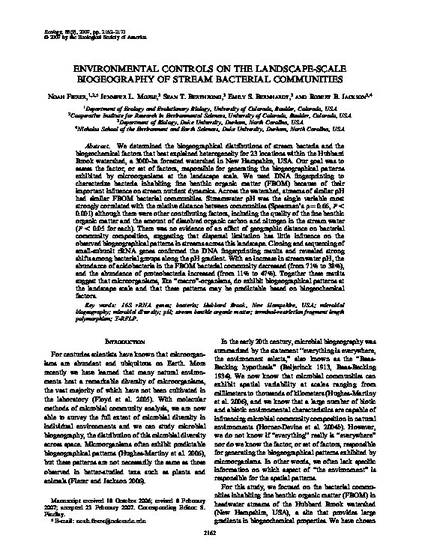
- Bacteria,
- Biogeochemistry,
- Watersheds,
- Microbial diversity
We determined the biogeographical distributions of stream bacteria and the biogeochemical factors that best explained heterogeneity for 23 locations within the Hubbard Brook watershed, a 3000-ha forested watershed in New Hampshire, USA. Our goal was to assess the factor, or set of factors, responsible for generating the biogeographical patterns exhibited by microorganisms at the landscape scale. We used DNA fingerprinting to characterize bacteria inhabiting fine benthic organic matter (FBOM) because of their important influence on stream nutrient dynamics. Across the watershed, streams of similar pH had similar FBOM bacterial communities. Streamwater pH was the single variable most strongly correlated with the relative distance between communities (Spearman's ρ = 0.66, P < 0.001) although there were other contributing factors, including the quality of the fine benthic organic matter and the amount of dissolved organic carbon and nitrogen in the stream water (P < 0.05 for each). There was no evidence of an effect of geographic distance on bacterial community composition, suggesting that dispersal limitation has little influence on the observed biogeographical patterns in streams across this landscape. Cloning and sequencing of small-subunit rRNA genes confirmed the DNA fingerprinting results and revealed strong shifts among bacterial groups along the pH gradient. With an increase in streamwater pH, the abundance of acidobacteria in the FBOM bacterial community decreased (from 71% to 38%), and the abundance of proteobacteria increased (from 11% to 47%). Together these results suggest that microorganisms, like “macro”-organisms, do exhibit biogeographical patterns at the landscape scale and that these patterns may be predictable based on biogeochemical factors.

This is the publisher's final pdf. Reproduced here with author and publisher permissions.